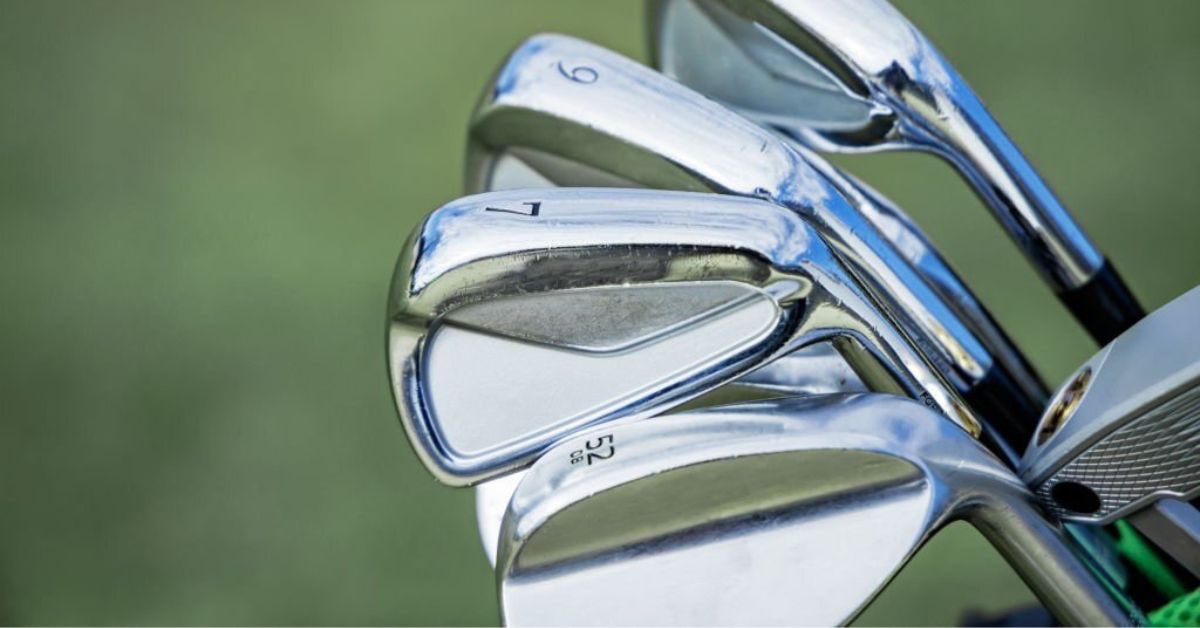While looking similar, irons and wedges serve different purposes. Irons are for mid to long-distance shots, while wedges are for versatile shots into the green.
That said, what’s the difference between irons and wedges?
In this article, you’ll learn the main differences between irons and wedges — and how these design differences translate to performance on the golf course.
Difference Between Irons and Wedges
Technically, wedges are a subset of irons. However, they are seen as separate categories due to some key differences. Essentially, the main difference between irons and wedges is loft angle. Wedges have more loft. Also, wedges have shorter shafts and more bounce options to suit different courses and swings.

Wedges Are Irons (Technically)
Historically, all clubs made with a blade-like metal head are known as irons. Wedges technically fall within this category, despite having a different name.
Irons have relatively small, blade-like heads and tend to range from 2 to 9-iron. They are used for mid to long-distance shots on the golf course.
Wedges have a similar appearance but with more loft. They are used for short-range approaches into the green — including pitch shots and chip shots.
Ultimately, wedges are often seen as an entirely different category.
This helps to differentiate between the two types of golf clubs. If you asked for a wedge out on the course, you wouldn’t want to be handed an iron — and vice versa!
Read on to learn the key differences between irons and wedges.

The Main Differences
These are the key differences between irons and wedges:
- Loft angle
- Shaft length
- Bounce angle
Let’s cover each difference in some detail.
1. Loft Angle
The loft angle is the main difference between irons and wedges. In short, irons have a lower degree of loft on the clubface, while wedges have more loft.
In golf, the distance the ball travels from a full swing is determined by the amount of loft on the clubface. As a rule of thumb, 1 degree of loft equals around 2-4 yards.
Essentially, irons typically range from 18º to 42º of loft (2-iron to 9-iron).
Conversely, wedges have from 46º to 60º of loft (pitching wedge to lob wedge).
Irons have less loft to strike the ball longer distances on the course, while wedges have more loft for shorter approach shots into the green.
The table below shows the loft angle for each club, from 2-iron to lob wedge:
| Club | Avg. Loft (Degrees) | Avg Distance (Yards) |
| 2 iron | 18º | 190 |
| 3 iron | 21º | 180 |
| 4 iron | 24º | 170 |
| 5 iron | 27º | 160 |
| 6 iron | 30º | 150 |
| 7 iron | 34º | 140 |
| 8 iron | 38º | 130 |
| 9 iron | 42º | 120 |
| Pitching wedge | 46º | 105 |
| Gap wedge | 52º | 90 |
| Sand wedge | 56º | 80 |
| Lob wedge | 60º | 70 |
2. Shaft Length
Another key difference between irons and wedges is the length of the shaft.
Typically, wedge shafts are shorter than iron shafts. This is because short shafts allow for more control of the clubface, which is vital for delicate pitch and chip shots.
In fact, irons usually get progressively shorter as the loft angle increases. Essentially, shorter shafts produce less ball speed and less distance. This, combined with higher loft angles, allows for useful distance gapping between each club.
Let’s take a 7-iron. On average, this club will be much longer than any wedge as it’s designed to generate more speed and hit the ball longer distances.
However, this isn’t a one-size-fits-all approach. For instance, Bryson DeChambeau notably uses single-length irons, making loft angle the sole variable.
Ultimately, wedges are shorter than irons to allow tighter swings and better control.
3. Bounce Angle
Finally, the bounce on the sole of the club varies between irons and wedges.
PRO TIP: The bounce angle is the angle between the leading edge and the lowest point of the sole of the club. In essence, more bounce is more forgiving for steep swings and soft turf conditions.
With wedges, turf interaction is particularly important for the quality of the strike. While you can get away with ‘sweeping’ your iron shots, it’s less forgiving with wedges.
Therefore, wedges tend to have more bounce than irons.
For instance, it’s common to choose between 8 or 12 degrees of bounce for gap wedges, while long irons can have as little as 1-2 degrees of bounce.

Wedge Swing vs Iron Swing
So, we’ve established that despite being in the family of irons, wedges are designed differently to enable additional control on shots in and around the green.
There are also subtle differences between the wedge swing and the iron swing.
The Wedge Swing
With wedges, your aim is often to pitch the ball as close to the pin as possible. That means you need lots of control over the clubface to produce a solid strike.
To achieve this level of control, focus on these three swing thoughts:
- Ball position slightly back in your stance
- Slight forward press in your hands at address
- Maximum of 80% power in full swings
Essentially, a three-quarter swing ensures you remain in control. While you should have a full turn through the swing, the hands shouldn’t raise above the shoulders.
The Iron Swing
Conversely, for the iron swing, you want to swing with slightly more speed. This will allow you to maximize the distance you can achieve with each club.
To do this, focus on the following tips:
- Ball position slightly forward in your stance
- Slight forward press in your hands at address
- Maximum of 90% power in full swings
So, you should swing closer to 90% with irons. That means making a full rotation, raising the hands above the shoulder line in both the backswing and the follow-through.
Ultimately, the main differences between the wedge swing and the iron swing are the amount of power you use, and the length of the swing.
Conclusion
In summary, wedges are technically a subset of irons. However, they are seen as a different category due to key differences. This includes:
- Loft angle — Wedges have more loft than irons
- Shaft length — Wedges have shorter shafts than irons
- Bounce angle — Wedges have more bounce than irons
Irons are designed primarily for full-swing approach shots, while wedges require more flexibility and control for the delicate pitch and chip shots around the greens.


